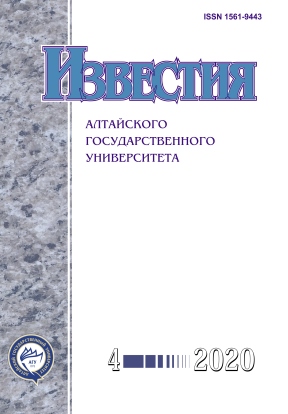The Effect of Pressure on the Structure and Electronic Properties of Hydrated Calcium Carbonates
УДК 548
Abstract
This paper studies the effect of pressure on the structure and electronic properties of CaCO3-H2O and CaCO3-6H2O crystalline hydrates. The study is based on the density functional theory (DFT) and the linear combination of atomic orbitals (LCAO) method. Calculations are performed using the CRYSTAL17 software package and the PBE gradient functional. The calculated lattice parameters of hydrated calcium carbonates and their dependence on external hydrostatic pressure are shown to be in good agreement with the available experimental measurements. Dependencies of linear compressibility on the direction are obtained using the calculated pressure dependencies of the structural parameters. It is demonstrated that the linear compressibility of calcium carbonate hexahydrate, in contrast to calcium carbonate monohydrate, is highly anisotropic (the smallest and largest compressibility values are correlated as K max/K min ~ 4). In this case, the maximum compressibility is located between crystallographic axes (between the axes a and c) and not along the crystallographic axes. The bulk modulus for the monohydrate (CaCO3-6H2O) is greater than for the hexahydrate (CaCO3-6H2O). Total and partial densities of electronic states for CaCO3-H2O and CaCO3-6H2O are calculated. Also, dependencies of the band gap width on pressure for hydrated calcium carbonates are established. It is shown that, with increasing pressure, the increase of the band gap is greater for CaCO3-6H2O than for CaCO3-H2O.
Downloads
Metrics
References
Javoy M., Pineau F., Allbgre C. Carbon geodynamic cycle // Nature. 1982. Vol. 300. DOI: 10.1038/300171a0.
Zhang Y., Zindler A. Distribution and evolution of carbon and nitrogen in Earth // Earth Planet. Sci. Lett. 1993. Vol. 117. DOI: 10.1016/0012-821X(93)90088-Q.
Lee K., Wagermaier W, Masic A., Kommareddy K.P., Bennet M. Self-assembly of amorphous calcium carbonate microlens arrays // Nature Comm. 2012. Vol. 3. DOI: 10.1038/ncomms1720.
Hirano S., Yogo T., Kikuta K. Synthetic calcite single crystals for optical device // Prog. Crystal Growth and Charact. 1991. Vol. 23. DOI: 10.1016/0960-8974(92)90027-N.
Addadi L., Raz S., Weiner S. Amorphous calcium carbonate and its roles in biomineralization // Adv. Mater. 2003. Vol. 15. DOI: 10.1002/adma.200300381.
Nooijer L.J., Spero H.J., Erez J., Bijma J., Reichart G.J. Biomineralization in perforate foraminifera // Earth-Science Reviews. 2014. Vol. 135. DOI: 10.1016/j.earscirev.2014.03.013.
Lennie A.R., Tang C.C., Thompson S.P. The structure and thermal expansion behavior of ikaite, CaCO3-6H2O, from 7=114 to T=293 K // Mineral. Magaz. 2004. Vol. 618. DOI: 10.1180/0026461046810176.
Marschner H. Hydrocalcite (CaCO3-H2O) and nes-quehonite (MgCO3-3H2O) in carbonate scales // Science. 1969. Vol. 165. DOI: 10.1126/science.165.3898.1119.
Swainson I.P The structure of monohydrocalcite and the phase composition of the beachrock deposits of Lake Butler and Lake Fellmongery // Am. Mineral. 2008. Vol. 93. DOI: 10.2138/am.2008.2825.
Tateno N., Kyono A. Structural change induced by dehydration in ikaite (CaCO3-6H2O) // J. Mineral. Petrol. Sci. 2014. Vol. 109. DOI: 10.2465/jmps.140320.
Lennie A.R. Ikaite (CaCO3-6H2O) compressibility at high water pressure: a synchrotron X-ray diffraction study // Mineral. Magaz. 2005. Vol. 69. DOI: 10.1180/0026461056930254.
Demichelis R., Raiteri P., Gale J.D. Structure of hydrated calcium carbonates: A first-principles study // J. Cryst. Growth. 2014. Vol. 401. DOI: 10.1016/j.jcrysgro.2013.10.064.
Costa S.N., Freire V.N., Caetano E.W., Maia F.F., Barboza C.A. DFT Calculations with van der Waals Interactions of Hydrated Calcium Carbonate Crystals CaCO3-(H2O, 6H2O): Structural, Electronic, Optical, and Vibrational Properties // J. Phys. Chem. A. 2016. Vol. 120. DOI: 10.1021/acs.jpca.6b05436.
Korabel’nikov D.V, Zhuravlev Yu.N. Compressibility Anisotropy and Electronic Properties of Oxyanionic Hydrates // J. Phys. Chem. A. 2017. Vol. 121. DOI: 10.1021/acs.jpca.7b04776.
Becke A.D. Perspective: Fifty years of density-functional theory in chemical physics // J. Chem. Phys. 2014. Vol. 140. DOI: 10.1063/1.4869598.
Dovesi R., Erba A., Orlando R, Zicovich-Wilson C.M., Civalleri B. Quantum-mechanical condensed matter simulations with CRYSTAL // WIREs Comput. Mol. Sci. 2018. Vol. 8. DOI: 10.1002/wcms.1360.
Perdew J.P, Burke K., Ernzerhof M. Generalized gradient approximation made simple // Phys. Rev. Lett. 1996. Vol. 77. DOI: 10.1103/PhysRevLett.77.3865.
CRYSTAL-Basis Sets Library. URL: https://www.crystal.unito.it/basis-sets.php.
Broyden C.G. The convergence of a class of double-rank minimization algorithms // J. Appl. Math. 1970. Vol. 6. DOI: 10.1093/imamat/6.3.222.
Cliffe M.J., Goodwin A.L. PASCal: a principal axis strain calculator for thermal expansion and compressibility determination // J. Appl. Cryst. 2012. Vol. 45. DOI: 10.1107/ S0021889812043026.
Izvestiya of Altai State University is a golden publisher, as we allow self-archiving, but most importantly we are fully transparent about your rights.
Authors may present and discuss their findings ahead of publication: at biological or scientific conferences, on preprint servers, in public databases, and in blogs, wikis, tweets, and other informal communication channels.
Izvestiya of Altai State University allows authors to deposit manuscripts (currently under review or those for intended submission to Izvestiya of Altai State University) in non-commercial, pre-print servers such as ArXiv.
Authors who publish with this journal agree to the following terms:
- Authors retain copyright and grant the journal right of first publication with the work simultaneously licensed under a Creative Commons Attribution License (CC BY 4.0) that allows others to share the work with an acknowledgement of the work's authorship and initial publication in this journal.
- Authors are able to enter into separate, additional contractual arrangements for the non-exclusive distribution of the journal's published version of the work (e.g., post it to an institutional repository or publish it in a book), with an acknowledgement of its initial publication in this journal.
- Authors are permitted and encouraged to post their work online (e.g., in institutional repositories or on their website) prior to and during the submission process, as it can lead to productive exchanges, as well as earlier and greater citation of published work (See The Effect of Open Access).








